Serviços Personalizados
Journal
Artigo
Indicadores
-
 Citado por SciELO
Citado por SciELO -
 Acessos
Acessos
Links relacionados
-
 Similares em
SciELO
Similares em
SciELO
Compartilhar
Revista de Ciências Agrárias
versão impressa ISSN 0871-018X
Rev. de Ciências Agrárias vol.36 no.1 Lisboa jan. 2013
Nitrogen use efficiency by cotton varieties
Eficiência no uso de nitrogênio por variedades de algodão
Érica de Oliveira Araújo1, Marcos Antonio Camacho2 and Marion Martins Vincensi3
1University Federal of Great Dourados, Rod. Dourados/Itahum, 12 km, Dourados, MS, Brazil. E-mail: ericabb25@hotmail.com, author for correspondence.
2Department of Agronomy, State University of Mato Grosso do Sul, Rod Aquidauna / Piraputanga, km 12, 79200-000, Aquidauana, MS, Brazil. E-mail:camacho@uems.br.
3State University of Mato Grosso do Sul, UEMS, University Unity of Aquidauana, Rod CERA 12 km, Aquidauana, MS, Caixa postal 25, CEP 79200-000. E-mail: marionvincensi@hotmail.com.
ABSTRACT
This study aimed to evaluate the nitrogen use efficiency by different cotton varieties in an Acrisol. The design was com- pletely randomized in a 5x2x5 factorial. The factors consisted of five nitrogen rates (0, 250, 500, 750 and 1000 mg dm-3 of soil), two cotton genotypes (FiberMax 910 and FiberMax 966) and five repetitions, using urea as source N (45% N). The following variables were studied: dry matter production of plant shoots, nitrogen content, nitrogen concentration, N use efficiency, efficiency of nitrogen applied, physiological efficiency, agro-physiologic efficiency and recovery efficiency. The results showed that there was a significant linear effect of nitrogen application in the dry matter production, nitrogen content and nitrogen concentration of cotton plant. The nitrogen use efficiency varied with the genotypes and type of ef- ficiency calculated, and with increasing doses of N, less N was recovered by cotton plants.
Keywords: Efficiency, Gossypium hirsutum L., mineral nutrition, nitrogen fertilization
RESUMO
O presente trabalho teve por objetivo avaliar a eficiência de utilização do nitrogênio por diferentes variedades de algodão em um Argissolo Vermelho-Amarelo. O delineamento utilizado foi inteiramente casualizado em esquema fatorial 5x2x5. Os fatores constituíram-se de cinco doses de nitrogênio (0, 250, 500, 750 e 1000 mg dm-3 de solo) duas variedades de algodão (FiberMax 910 e FiberMax 966) e cinco repetições, utilizando-se como fonte a uréia (45% N). Foram determinadas as seguintes variáveis: produção matéria seca parte aérea, teor de nitrogênio, conteúdo de nitrogênio, eficiência de utilização N, eficiência do N aplicado, eficiência fisiológica, eficiência agrofisiológica e eficiência de recuperação. Os resultados permitiram concluir que a produção de massa seca, o teor e conteúdo de nitrogênio em plantas de algodão são influenciados pelas doses de nitrogênio. A eficiência de utilização do nitrogênio varia de acordo com os genótipos e o tipo de eficiência calculada; e com o aumento das doses de N, menos N foi recuperado pelas plantas de algodão.
Palavras-chave: Eficiência, Gossypium hirsutum L., nutrição mineral, adubação nitrogenada
Introduction
Cotton represents great economic and social importance worldwide as it is among the ten largest sources of wealth in the agricultural sector. In the Brazilian agribusiness, cotton production has emerged as one of the main activities. The estimated cotton planted area in the 2009/2010 crop in Brazil was 836 0000 hectares with an estimated production of approximately 1993.8tons of seed cotton (CONAB, 2010). According to Macedo (1996), the Brazilian Cerrado has an area of approximately 207 million hectares, of which approximately two thirds of this area is considered suitable for food production. However, Machado et al. (2001) report that the Cerrado has certain limitations such as high acidity and low natural fertility (Fageria, 1998).
The selection of genetic materials adapted to conditions of low soil fertility increases the utilization of fertilizers, promoting greater production in soils of low fertility (Fernandes and Muraoka, 2002). According to Yan et al. (1995), the solution to increase productivity and reduce production costs is the selection of efficient genotypes in the uptake and use of nutrients, which is defined, according to Goedert and Lobato (1980), as the genotype ability to acquire the nutrient from the soil, incorporate it and use it.
According to Beltrão (1999), cotton requires relatively large amounts of nitrogen compared with the demand for other elements, to obtain maximum yield. Nitrogen is the nutrient most absorbed by cotton plants, and therefore, it plays an important role in plant growth and development, especially of vegetative organs, stimulates growth and flowering, regulates the plant cycle, increases productivity and improves the fiber length and strength when applied in appropriate doses (Beltrão, 1999).
The nitrogen efficiency depends basically on the following factors: doses applied, sources used, time and form of application, climatic conditions, intensity of cultivation area, availability of phosphorus, potassium, calcium and magnesium, cropping system, rotation of crops and use of growth regulators (Castro, 2004).
Furlani and Buzetti (2001) reported that when nitrogen was applied 30 days after plant emergence, the doses of 40 and 70 kg N ha-1 provided the highest plant height values when compared with those observed for doses of 30 kg ha-1 N. According to Campos et al. (1995), as the dose of N increased from 0 to 50, 100, 150 and 200 kg ha-1, a significant and directly proportional effect occurred in terms of cotton production. Grespan and Zancanaro (1999), Oliveira et al. (1988) and Campos et al. (1995) reported that the application of increasing doses of N (0, 60, 120 and 180 kg ha-1) increased productivity up to the dose of 120 kg ha-1.
Bondada et al. (1997) reported that the nitrogen requirement by cotton is high, especially during the reproductive phase, when the bolls import large amounts of N from leaves, causing a decline in the photosynthetic activity. Thus, the importance of the correct time, form of application and appropriate application of nitrogen fertilizer should be emphasized.
Mendes (1965) observed that the period of greatest N uptake is from 30 to 90 days after emergence. Furlani Júnior et al. (2001) found that the application and split nitrogen fertilization at doses of 20, 40 and 70 kg ha-1 caused positive responses when it was performed at 40 days after emergence.
According to Gerik et al. (1998), nitrogen uptake is proportional to the photosynthetic capacity and to the dry mass accumulation of cotton plants. In this context, among the macronutrients, nitrogen shows the largest use increment. The reasons are its high absorption rate by the cotton plant, its low availability in Cerrado soils and the physiological role that nitrogen plays in plant growth and development (Camacho et al., 2009).
Given the above, this study aimed to evaluate the nitrogen use efficiency by different cotton varieties in a red-yellow ultisol.
Material and Methods
The experiment was conducted at the experimental area of the Campus of Aquidauana, belonging to the Department of Crop Production, State University of Mato Grosso do Sul UEMS, in the period from August to December 2009 in greenhouse conditions, geographical coordinates of 40° 28 S, 35° 40 W to 207 meters altitude.
The soil used in the experiment was an Acrisol.
The soil chemical analysis showed pH (H2O) = 4.7; O.M=1.2%; P: 4.4 mg/dm3; K: 0.24 mg/dm3; Ca: 1.1 mg/dm3; Mg: 1.2 mg/dm3, Al: 0.4 mg/dm3; H+Al: 2.7 mg/dm3, EC [Electrical Conductivity]: 2.54 mg/dm3 and CEC [Cation exchange capacity]: 5.24 mg/dm3, respectively and SB [Base saturation] (%): 48.47.
The design used was completely randomized in a 5x2x5 factorial. The factors consisted of five nitrogen rates (0, 250, 500, 750 and 1000 mg dm-3 of soil), two cotton varieties (FiberMax 910 and FiberMax 966) and five repetitions, using urea as N source (45% N).
Pots with capacity of 5 dm 3 were used, which received 5 kg of sieved soil 0-20 cm layer (2mm mesh).Each pot was lined with thick plastic bags to prevent leaks. Five seeds pot-1 were sown and after the establishment of plants, they were thinned to two seedlings pot-1. Irrigation was carried out whenever necessary to maintain 70% of maximum water-holding capacity.
Nitrogen fertilization was performed half at the sowing period as urea, and the rest 30 days after planting, also as urea. Nutrients phosphorus (P) and potassium (K) were provided for all treatments in the same quantity according to soil analysis, using triple superphosphate and potassium chloride. At 120 days after emergence, the tops of plants were removed, which were weighed, washed in distilled water, and dried in an oven with forced air at 65°C for 72 hours, weighed, ground in a Wiley type mill (sieve with mesh diameter of 1 mm) and submitted to determinations of the nitrogen concentration using the Kjeldahl method (Malavolta et al., 1997), i.e., sulfuric acid digestion followed by distillation and titration.
The following variables were determined, as described by Baligar and Fageria (1999): Nitrogen use efficiency (NUE): total dry matter produced (g) / total nutrient content in plant (mg). Physiological efficiency (PE): (BPf BPnf) / (ANf ANnf) was given in kg kg-1, in which BPf is the biological production (straw and grain) with nitrogen fertilizer; BPnf is the biological production (straw and grains), without nitrogen fertilizer; (ANf is the accumulation of N in plant top and grains, with nitrogen fertilizer, and ANnf is the accumulation of N in plant top and grains, without nitrogen fertilizer. Agro-physiologic efficiency (APE): (GPf GPnf) / (ANf ANnf) was given in kg kg-1, in which GPf is the grain production, with nitrogen fertilizer; GPnf is the grain production without nitrogen fertilizer; ANf is the accumulation of N in plant top and grains with nitrogen fertilizer, and ANnf is the accumulation of N in plant top and grains without nitrogen fertilizer. Applied nitrogen efficiency: plant nitrogen content (mg) / dose of fertilizer multiplied by 100 and multiplied by the N use efficiency. Recovery efficiency (RE): 100 (ANf ANnf / ANa) was given in percentage, in which ANf is the accumulation of N in plant top and grains with nitrogen fertilizer; ANnf is the accumulation of N in plant top and grain without fertilizer, and ANa is the amount of N applied in kg.
The data were submitted to the W test for normality and in case of normal distribution, the analysis of variance was performed using the Statistical Analysis System [SAS] software. After descriptive analysis, the data were used to establish linear conditions (Pearson, p=0.05).
Results and discussion
There was a significant response (p<0.05) to rates of nitrogen of dry mass of shoots, nitrogen content, accumulated nitrogen, nitrogen use efficiency, efficiency agro-physiological of nitrogen and nitrogen efficiency applied (Table 1). Only nitrogen physiological efficiency was not affected by doses of nitrogen for both varieties of cotton (Table 1).
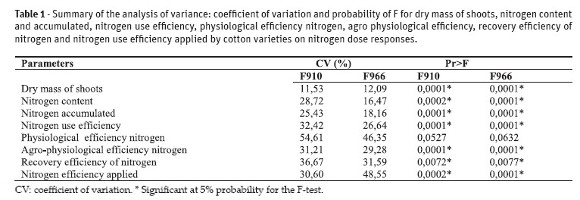
The dry mass of top was influenced by rate of nitrogen, so that the largest rates of N provided greater accumulation of dry mass of cotton varieties (Figure 1). However, there was a tendency for higher production by varied FiberMax 910. Estimated by the equation, the maximum dry mass production was 36.54 g per pot for FiberMax 910 and 35.72 g per pot for FiberMax 966, obtained at a dose of 1000 mg dm 3, and this must have occurred due to the increased availability of this nutrient. This variation is related to the absorption capacity and nutrient use by the varieties; however, this does not indicate that they are more or less efficient in absorbing soil N.
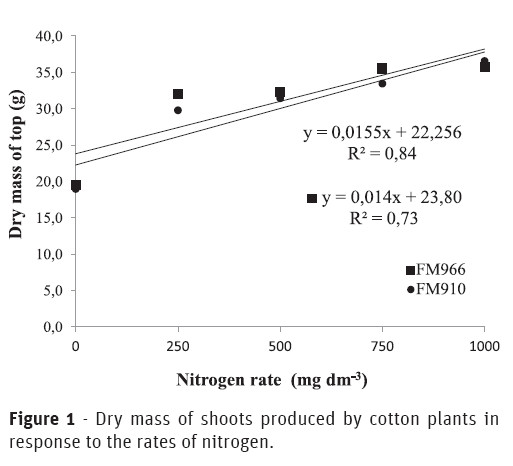
The content and the accumulated N in the shoots were influenced by the rate of N (Figure 2a and 2b). The amount of N in the tissue of the plant was greater than the amount of N applied. This result was expected because plants can obtain nitrogen from atmospheric deposition, biological nitrogen fixation or soil organic matter. Foliar nitrogen varied from 20.51 g kg-1 in FiberMax 910 to 15.38 g kg-1 in FiberMax 966, being lower at rates 0 and 250 mg dm-3 N. The findings are contrary to those found by other authors, with N contents outside the range of suitable levels (35-43 g kg-1), according to criteria established by Silva et al. (1999). Figure 2 shows that the N content in cotton leaves increased linearly with the nitrogen doses applied. Zhao et al. (2005) reported that foliar N was closely linked with the consequent increase in the nitrogen levels applied to soil. Ibrahim et al. (2010) found that the nitrogen content in cotton shoots of three varieties increased significantly with increasing levels of nitrogen added without any indication of the variety x interaction of nitrogen. Nakayama et al.(2004) tested increasing nitrogen doses in IAC 23 cultivar and found significant foliar N values from 48.05 to 52.92 g kg-1. Camacho et al. (2009), obtained foliar nitrogen values between 30.923 and 54.045 g kg-1 and the highest seed cotton yields were associated with levels of 42 and 44 g kg-1, with a productivity peak at 47 g kg -1 of foliar nitrogen.
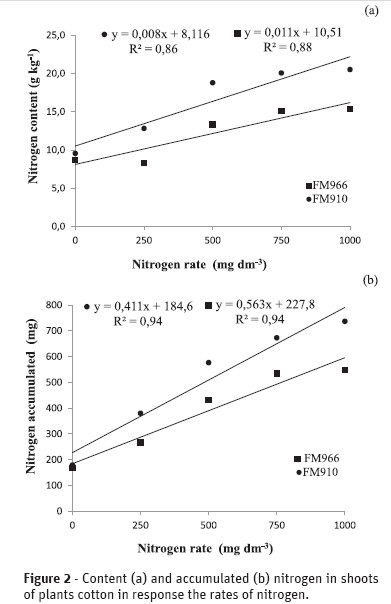
The varieties showed a linear negative and significant (p<0.05) behavior of the nitrogen use efficiency in function of N rate (Figure 3). Variety FiberMax 910 showed better performance in the nitrogen use efficiency when compared to variety FiberMax 966; however, this efficiency decreased with increasing nitrogen doses, not responding to the high level of this nutrient. The efficiency ranged from 4,7 a 5,5 g mg-1 dry weight per milligram of absorbed nitrogen. Similar results were obtained by Nedel et al. (1997), who observed that the N use efficiency in barley genotypes decreased with increasing rate of N. There are several mechanisms related to morphological and physiological characteristics of the plant, which contribute to the efficient use of nutrients, including a high ratio between plant top and roots. Thus, there should be a direct correlation for this attribute, i.e., the higher the top / root ratio, the greater the nutritional efficiency of the cultivar (Fageria and Baligar, 1993).
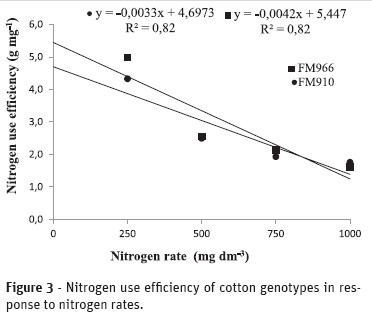
The efficiency of use of the nitrogen applied was reduced with increasing rate of fertilizer, with being variety FiberMax 910 superior to variety FiberMax 966 (Figure 4). Similar results were obtained by Cruz et al., 2008, who found high N use efficiency for all corn cultivars. Ceretta (1998), using 30, 60 and 90 kg ha-1 of N in pre-seeding, providing an increase of 10, 13 and 18 kg grain kg -1 of applied N. Oliveira and Caires (2003) found an average production increase of 15.59 ha-1 of grain for each kg of N applied as top dressing with rates of 30, 60, 90 and 120 kg ha-1 N in no-tillage system.
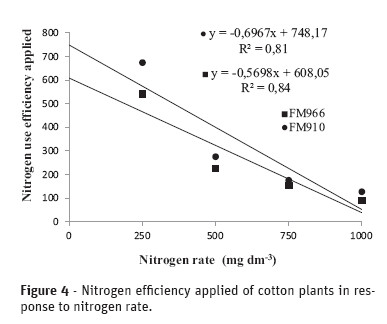
The N agro-physiological efficiency by cotton varieties presented negative linear effects in response to the rate of nitrogen, with variation of 0.016 to 0.050 mg of grain produced per gram of N accumulated (Figure 5). Fageria et al. (2003b) reported that accumulation of 1 kg of N in rice plant top and grains produced 146 kg of dry matter.
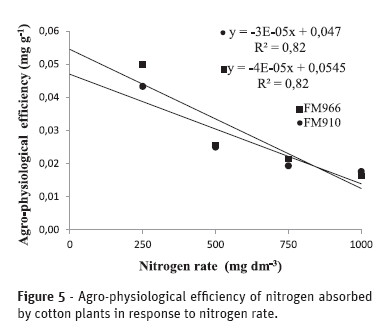
The recovery efficiency of N applied to cotton responded significantly (p<0.05) to the rate of nitrogen (Figure 6). It was found that the recovery of applied N ranged from 40 to 80% between genotypes, with an average value of 57%. With increasing doses of N, less N was usually recovered by plants. The results observed here, with an average recovery of 57%, occurred possibly due to the lower N immobilization, and also because at lower N doses, the fertilizer recovery tends to be higher (Gava et al., 2006; Silva et al., 2006). However, the recovery of a nutrient is dependent on the time elapsed after application and the dose applied. Besides the aspects discussed above on the volatilization of ammonia resulting from the enzymatic hydrolysis of urea, it should be considered that the fall of leaves also contributes to losses of N.
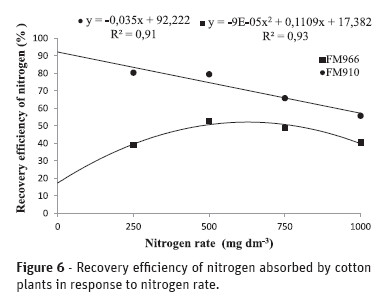
Conclusions
1. Dry matter production, the content and accumulated nitrogen in cotton plants are influenced by the rate of nitrogen.
2. The nitrogen use efficiency varies with the genotypes and the type of the efficiency calculated, and with increasing rate of N, less N was recovered by cotton plants.
Acknowledgements
The authors thank the Coordination for Improvement of Higher Education Personnel, CAPES for granting fellowships, and the State University of Mato Grosso do Sul UEMS, for financial support.
Bibliographic References
Baligar, V.C.; Fageria, N.K. (1999) Plant nutrient efficiency: towards the second paradigm. In: Siqueira, J.O.; Moreira, F.M.S.; Lopes, A.S.; Guilherme, L.R.G.; Faquin, V.; Furtini Neto, A.E.; Carvalho, J.G. (Eds.) Soil fertility, soil biology, and plant nutrition interrela tionships. Lavras, SBCS/ UFLA, p. 183-204. [ Links ]
Beltrão, N.E. de M. (1999) Brazilian Cotton from: Situation and prospects. In: Beltrão, N.E. de M.- Agribusiness cotton in Brazil. Brasília, Embrapa Communication for technology transfer, 1:15-27. [ Links ]
Bondada, B.R.; Oosterhuis, D.M. and Norman, R.J.(1997) Cotton leaf age, epicuticular wax, and nitrogen-15 absorption. Crop Science, Madson, 37: 807-811. [ Links ]
Castro, M.F. (2004) - Response of cotton cultivars herbaceous doses of nitrogen and mepiquat chloride. Thesis masters degree in production system. Faculty of engineering of Ilha Solteira. Ilha Solteira, University Unity Paulista, 50 p. [ Links ]
Campos, T.G.S; Oliveira, F.A.; Silva, O.R.R.F. and Santos, J.W. (1995) Effects of doses and times of applying nitrogen ammonium sulphate on irrigated cotton. In: Proceedings 8st National Meeting of cotton. Londrina, Brazil, Embrapa Cotton, 118 p. [ Links ]
Camacho, M.A.S.; Beltramin, R.C.; Ruiz, J.G.C.L.; Ecco, M.; Marcante, N.C. and Paredes Junior, F.P.(2009) Nitrogen fertilization in transgenic cotton in conventional tillage system. In: Proceedings 7st Brazilian Congress of Cotton. Foz do Iguaçu, Brazil, Embrapa Cotton, p. 1900-1908. [ Links ]
Carvalho, M.M. and Saraiva, O.F. (1987) Response by fat grass (Melinis minutiflora Beau.) application of nitrogen, under cuts. Journal Brazilian of Zootechny, Viçosa: 16, 5: 442-454. [ Links ]
Ceretta, C.A. (1998) Nitrogen fertilization in tillage system: succession oats/corn. In: Proceedings 2st Annual Conference of Tillage. Ijuí, Brazil, p. 49-62. [ Links ]
CONAB [Companhia Nacional de Abastecimento] (2010) - Monitoring of Brazilian grain Harvest 2009/2010: Eighth Survey, Maiol/2010, National supply Company. Brasilia, CONAB, 38 p. [ Links ]
Cruz, S.C.S.; Pereira, F.R.S.; Santos, J.R.; Albuquerque, A.W. and Pereira, R.G. (2008) Nitrogen fertilization for corn grown in tillage system in the State of Alagoas. American Journal of Agricultural and environmental Engineering, 12: 62–68. [ Links ]
Fageria, N.K.; Stone, L.F. and Santos, A.B. dos (2003) - Soil fertility Management for irrigated rice. Santo Antônio de Goiás, Embrapa rice and beans, 250 p. [ Links ]
Fageria, N.K. and Baligar, V.C. (1993) Screening crop genotypes for mineral stresses. In: Proceedings Workshop on adaptation of plants to soil stresses.Lincoln, University of Nebraska, p.142-159. [ Links ]
Fageria, N.K. (1998) Efficiency of use of phosphorus by the genotypes of beans. American Journal of Agricultural and environmental Engineering, Campina Grande, 2: 119-246. [ Links ]
Fernandes, C. and Muraoka, T. (2002) Absorption of Phosphorus by Hybrid maize grown in soil.Scientia Agricola, 59:781-787. [ Links ]
Furlani, E.J. and Buzetti, S. (2001) Dosages and moments of nitrogen fertilizer application to the culture of the cotton plant (Gossypium hirsutum L.) IAC 225. In: Proceedings 3st Brazilian Brazilian Congress of Cotton. São Paulo, Brazil, Embrapa Cotton, p. 719-725. [ Links ]
Furlani, E.J. and Buzetti, S. (2001) Characteristics of fiber in function of doses and moments of nitrogen fertilizer application to the culture of the cotton plant (Gossypium hirsutum l.) IAC 22. In: Proceedings 3st Brazilian Congress of Cotton. São Paulo, Brazil, Embrapa Cotton, p. 714-718. [ Links ]
Gava, G.J.C.; Trivelin, P.C.O.; Oliveira, M.W.; Heinrichs, R. and Silva, M.A. (2006) Urea nitrogen Balance (15N) in soil-plant system in the deployment of direct seeding cultivation of maize. Bragantia, 65: 477-486. [ Links ]
Gerik, T.J.; Osterhuis, D.M. and Torbert, A. (1998) Managing cotton nitrogen supply. Advances in Agronomy, Newark, 64:117-147. [ Links ]
Goedert, W.J. and Lobato, E. (1980) Agronomic Efficiency of phosphates in soil. Brazilian agricultural research agency, 15: 311-318. [ Links ]
Grespan, S.L. and Zancanaro, L. M.T. (1999) - Mato Grosso Foundation: Leadership and Competitiveness. Rondonopolis, Foundation MT; Campina Grande, Embrapa Cotton. p. 87-99. [ Links ]
Macedo, J. (1996) The soils of the region of the Cerrado. In: Alvarez, V.H. - Soil in large areas morfoclimáticos do Brasil and the sustained development. Viçosa, MG, SBCS e UFV, p.135-55. [ Links ]
Machado, C.T.T.; Furlani, A.M.C. and Machado, A.T. (2001) Indexes of efficiency and improved local varieties of maize to match. Bragantia (São Paulo),Campinas, 60:225-238. [ Links ]
Malavolta, E.; Vitti, G. C. and Oliveira, S.A. (1997) Evaluation of nutritional status of plants: principles and applications. 2ª ed. Piracicaba, POTAFOS, 319 p. [ Links ]
Mendes, H.C. (1965) Nutrition of Gossypium: IImineral Absorption put plants cultivated in nutritional solutions. Bragantia, Campinas, 19:435-442. [ Links ] Ibrahim, M.A.S.; Ahmes, K.E., Osman, S. Ali, E.T.S., and Hamada, A.A. (2010) Response of new cotton varieties to nitrogen fertilization in Sudan Gezira. African Journal of Agricultural Research, 5,11: 1213-1219. [ Links ]
Nedel, J.L.; Ullrich, S.E. and Pan, W.L. (1997) Nitrogen use by standard height and semi-dwarf barley isotypes. Search Agropecuaria Brazilian, 32:147-153. [ Links ]
Nakayama, F.T.; Santos, D.M.A.; Furlani, E.J. and Martinez, W.V. (2004) Evaluation of nutritional status of Gossypium subjected to increasing doses of nitrogen. In: Proceedings 26st Reunião Brasileira da Fertilidade do Solo, 10st Reunião Brasileira Sobre Micorrizas, 8st Simpósio Brasileiro de Microbiologia do Solo, 5st Reunião Brasiliera de Biologia do Solo. Lages, Brazil, p.1750-1755. [ Links ]
Oliveira, F.A.; Campos, T.G.S.; Souza, J.G. and Carvalho, O.S. (1988) Effects of nitrogen and phosphorus in the culture of the cotton plant herbaceous. In: Proceedings 5st National Meeting of Cotton. Campina Grande, Brazil, Company Brazilian Search Agropecuária, p.88. [ Links ]
Oliveira, J.M.S. de and Caíres, E.F. (2003) Nitrogen fertilization in coverage for the corn cultivated after black oats in tillage system.Acta Scientiarum Agronomy, Maringá, 25:351-357. [ Links ] Silva, N.M.; Carvalho, L.H.; Cantarella, H.; Bataglia, O.C.; Kondo, J.I.; Sabino, J.C. and Bortoletto, N.(1999) Use of ammonium sulphate and urea fertilizer from the cotton plant.Bragantia, Campinas, 52: 69-81. [ Links ]
Silva, E.C.; Muraoka, T.; Buzetti, S. and Trivelin, P.C.O.(2006) Nitrogen Management in corn in red latosol under tillage with different cover plants. Brazilian agricultural research agency, 41:477-486. [ Links ]
Zhao, D.; Reddy, K.R.; Kakani, V.G.; Read, J.J. and KotiI, S. (2005) Selection of optimum reflectance ratios for estimating leaf nitrogen and chlorophyll concentrations of field-grown cotton. Agronomy Journal, 97: 89-98. [ Links ]
Yan, X; Lynach, J.P. and Beebe, S.E. (1995) Genetic variation for phosphorus efficiency of common bean in constrasting soil types. I. Vegetative response. Crop Science, Madison, 35:1086-1093. [ Links ]
Recebido/Received: 2012.03.16
Aceitação/Accepted: 2013.02.05














